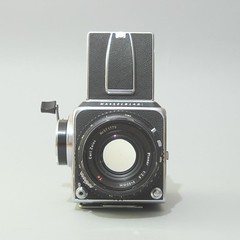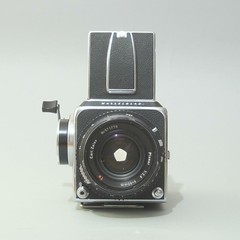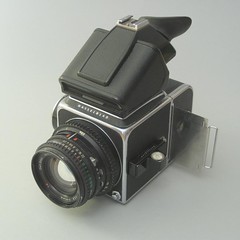Difference between revisions of "Hasselblad 500 C/M"
m (→Origins and name) |
m (→Origins and name) |
||
| Line 19: | Line 19: | ||
The '''Hasselblad''' 500C was intoduced in 1957 by the Hasselblad Corporation in Sweden, after a series of trouble-stricken 1600 and 1000 focal plane shuttered models. The camera number indicates the top shutterspeed. With the V-series, as the series started with the 500C is known, Hasselblad opted for an in the lens Compur shutter (hence the C). This solved the problems it had experienced with the focal plane shutters and allowed x-sync at all speeds. At the same time, it also meant a reduction of the top shutter speed to 1/500s. | The '''Hasselblad''' 500C was intoduced in 1957 by the Hasselblad Corporation in Sweden, after a series of trouble-stricken 1600 and 1000 focal plane shuttered models. The camera number indicates the top shutterspeed. With the V-series, as the series started with the 500C is known, Hasselblad opted for an in the lens Compur shutter (hence the C). This solved the problems it had experienced with the focal plane shutters and allowed x-sync at all speeds. At the same time, it also meant a reduction of the top shutter speed to 1/500s. | ||
| − | The 500C was produced from 1957 to 1970, after which the camera and backs were updated (''Modified'') according to Hasselblad. The | + | The 500C was produced from 1957 to 1970, after which the camera and backs were updated (''Modified'') according to Hasselblad. The ''modified'' version version was called 500CM. This newer version enabled the switching finder glasses and a new series of automatic backs were introduced (eg. the A12 magazine). |
| + | |||
| + | |||
| + | == A modular system camera == | ||
Following the design of the previous models, the Hasselblad Corporation designed the V-series to be completely modular: Not only the lenses are exchangeable, but also the viewfinder and the film magazines are exchangeable during normal operation of the camera. | Following the design of the previous models, the Hasselblad Corporation designed the V-series to be completely modular: Not only the lenses are exchangeable, but also the viewfinder and the film magazines are exchangeable during normal operation of the camera. | ||
Revision as of 20:57, 7 December 2006
Contents
Origins and name
The Hasselblad 500C was intoduced in 1957 by the Hasselblad Corporation in Sweden, after a series of trouble-stricken 1600 and 1000 focal plane shuttered models. The camera number indicates the top shutterspeed. With the V-series, as the series started with the 500C is known, Hasselblad opted for an in the lens Compur shutter (hence the C). This solved the problems it had experienced with the focal plane shutters and allowed x-sync at all speeds. At the same time, it also meant a reduction of the top shutter speed to 1/500s.
The 500C was produced from 1957 to 1970, after which the camera and backs were updated (Modified) according to Hasselblad. The modified version version was called 500CM. This newer version enabled the switching finder glasses and a new series of automatic backs were introduced (eg. the A12 magazine).
A modular system camera
Following the design of the previous models, the Hasselblad Corporation designed the V-series to be completely modular: Not only the lenses are exchangeable, but also the viewfinder and the film magazines are exchangeable during normal operation of the camera.
Of note in the modular design is the detail the Hasselblad Corporation has put in preventing user-errors related to the film-back: Presence of the dark slide in the back prevents exposure and allows removal of the back, whereas the filmback is locked to the body when the dark slide is removed. Also, both on the back and the body, colored indicators indicate the state of the shutter (cocked vs. released) and exposure (exposed vs. unexposed) on body and film back.
Optics and shutter
--> Zeiss, speeds, e-number
Magazines and film
--> 120, 220, 70mm, polaroid
Finders
--> wlf, prism, metered prism
Links
Images




